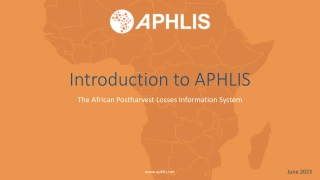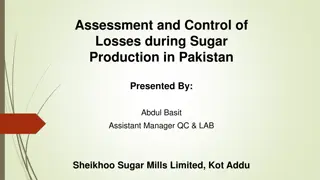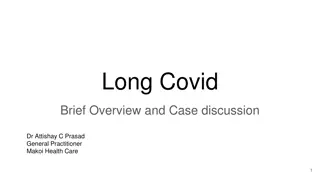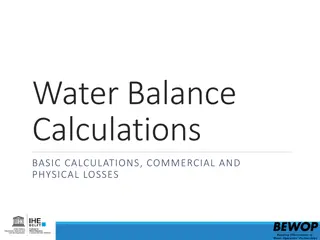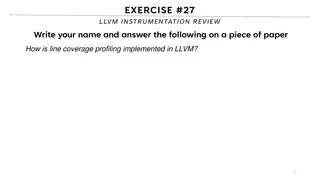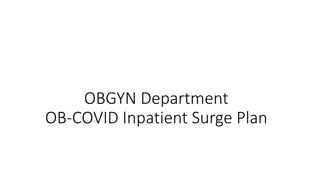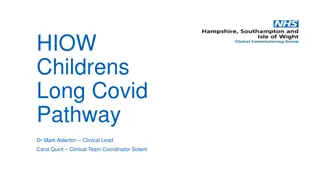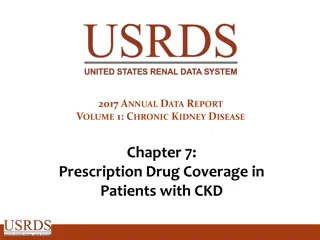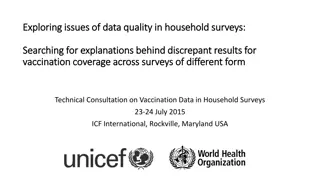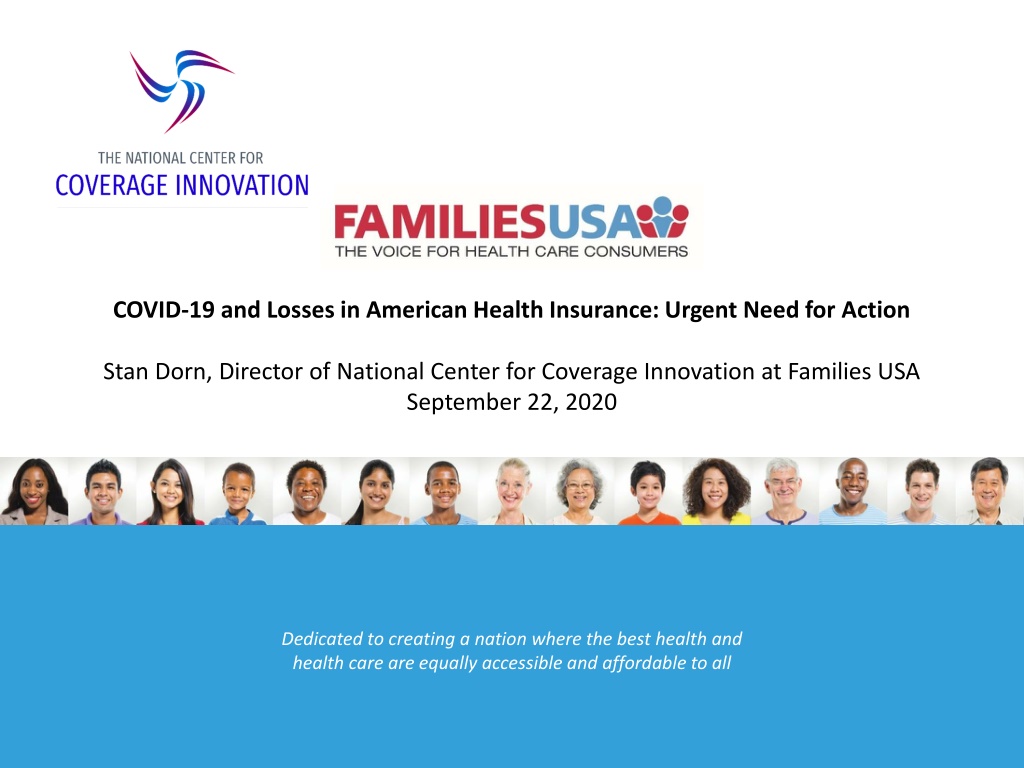
COVID-19 Impact on American Health Insurance: Urgent Call for Action
Amid the COVID-19 pandemic, there has been a concerning rise in the number of uninsured individuals, both children and adults, across racial and ethnic groups. The economic downturn has exacerbated the situation, leading to significant losses in health coverage. The need for immediate action to address this issue is crucial. Data shows a continuous increase in the number of uninsured individuals from 2016 to 2019, highlighting the urgent need for policymakers to intervene. Stay informed and take action to ensure accessibility and affordability of healthcare for all Americans.
Download Presentation

Please find below an Image/Link to download the presentation.
The content on the website is provided AS IS for your information and personal use only. It may not be sold, licensed, or shared on other websites without obtaining consent from the author. Download presentation by click this link. If you encounter any issues during the download, it is possible that the publisher has removed the file from their server.
E N D
Presentation Transcript
COVID-19 and Losses in American Health Insurance: Urgent Need for Action Stan Dorn, Director of National Center for Coverage Innovation at Families USA September 22, 2020 Dedicated to creating a nation where the best health and health care are equally accessible and affordable to all
Even before COVID-19 hit our shores, the number of uninsured was rising
The number of children and adults without insurance rose every year from 2016 through 2019 Changes in the number of uninsured after 2016, by age and year: 2010-2016 (thousands) 1,800 1,600 1,600 1,400 1,200 1,000 Adults (19-64) 800 800 Children (0-18) 600 700 400 400 400 200 300 0 2016 2017 2018 2019 Source: Analysis by National Center for Coverage Innovation at Families USA of American Community Survey data released on September 15, 2020. Health Insurance Historical Tables HIC ACS. https://www.census.gov/library/publications/2020/demo/p60-271.html 3
In every racial and ethnic group, the number of uninsured rose from 2016 through 2019 Changes in the number of uninsured after 2016, by race, ethnicity and year: 2010-2016 (thousands) 1,000 1,000 900 900 800 700 600 600 White, Non-Hispanic Latinx 500 400 400 African-American 400 300 300 Other 300 200 200 100 100 100 0 0 0 2016 2017 2018 2019 Source: Analysis by National Center for Coverage Innovation at Families USA of American Community Survey data released on September 15, 2020. Health Insurance Historical Tables HIC ACS. https://www.census.gov/library/publications/2020/demo/p60-271.html 4
The economic downturn triggered by COVID-19 is causing major losses of coverage 5
Not easy to know what is happening with health coverage in 2020 Definitive national survey data for 2020 are unavailable until mid- to late-2021. Policymakers need this information now. Coverage changes take time to unfold. Estimates and projections applying past coverage trends to current economic conditions Source Time period Lost employer-sponsored insurance (ESI) Increased uninsured Families USA 2020 effects of job losses in February to May n/a 5.4 million workers. > worst of Great Recession Urban Institute, May 2020 effects of 15% unemployment 17.7 30.0 million workers and dependents 5.1 8.5 million workers and dependents Urban Institute, July 2020 effects of unemployment forecast by CBO 10.1 million workers and dependents 2.9 million workers and dependents Kaiser Family Foundation 2020 effects of job losses between March 1 and May 2 26.8 million workers and dependents n/a Economic Policy Institute March and April job loss 3.2 million workers per month, net; > worst of Great Recession n/a 6
New survey results show mid-year coverage losses Household Pulse Survey (HPC), June to July* Avalere, Feb. to May HPC, April/May to July** HPC, Feb. to July*** 2 million increase uninsured adults in households losing earnings since March 3.3 million adults lost ESI, uninsured adults grew by 1.9 million Losing ESI: 6.2 million workers, >12 million people 12 million lost ESI Inequitable effects: African-Americans, families with children, low-wage workers, men, young adults Inequitable effects: Latinx, young adults, men, non- college educated Inequitable effects: African-Americans, Latinx No estimates of disparities *Analysis by Families USA **Analysis by Urban Institute ***Analysis by Economic Policy Institute 7
In 2020, we may see the largest coverage losses ever recorded Annual changes to the number of uninsured adults: 1980-2018 4 3 2 1 0 -1 -2 -3 -4 -5 -6 -7 -8 1993 2006 1983 1984 1985 1986 1987 1988 1989 1990 1991 1992 1994 1995 1996 1997 1998 1999 2000 2001 2002 2003 2004 2005 2007 2008 2009 2010 2011 2012 2014 2015 2016 2017 2018 1980-82 Source: National Center for Coverage Innovation at Families USA analysis of March Current-Population-Survey data. 8
Harm to consumers Health Financial security Economic recovery COVID-19 Other conditions Unpaid medical bills Forced to choose between health care and food Beating COVID-19 is key to recovery If patients lose insurance and don t seek care, health care providers must lay off staff 10
Short-term priorities FMAP COBRA SEP Increased APTCs for low- and moderate-income families Consumer Assistance 11
Conclusion Health-care stakeholders that disagree about the best future structure for U.S. health coverage share strong commitment to measures policymakers must take now to protect struggling families 12
Appendix: Putting recent coverage losses in context with major gains for children during the Great Recession and for all populations from 2010 to 2016
Well-stewarded child health programs grew stronger in past hard times. Health programs for children and adults weakened since 2016, despite good times. Despite the Great Recession of 2008-2010, Children s Health Programs Gained Ground Despite the Economic Boom of 2016-2019, Health Programs for Adults and Children Lost Ground 11.0 10.8 11.0 10.4 10.2 10.0 10.5 10.5 10.0 9.6 10.0 9.3 9.5 9.5 9.0 9.7 9.0 8.5 8.5 9.0 8.0 8.0 8.5 7.5 7.5 7.0 7.0 6.5 5.7 6.5 6.0 5.8 5.2 5.0 5.5 6.0 4.9 5.0 5.5 4.7 4.5 5.0 4.0 4.4 4.5 3.5 3.9 4.0 3.7 3.0 3.5 2016 2017 2018 2019 3.0 2008 2009 2010 Unemployment rate Unemployment rate Pecentage uninsured (under age 65) Percentage uninsured (children) Percentage uninsured (children) Sources: American Community Survey, Bureau of Labor Statistics, 2008-2019. 14
The number of children and adults without insurance declined every year from 2010 through 2016 Changes in the number of uninsured after 2010, by age and year: 2010-2016 (millions) 2010 2011 2012 2013 2014 2015 2016 -0.5 -0.8 -0.8 0.0 -1.8 -1.0 -0.4 -2.7 -0.8 -2.0 -3.0 -1.3 -3.0 -4.0 -5.0 -6.0 Children (0-18) -7.0 -8.0 Adults (19-64) -9.0 -8.8 -10.0 -11.0 -12.0 -13.0 -14.0 -15.0 -14.8 -16.0 -17.0 -16.9 Source: Analysis by National Center for Coverage Innovation at Families USA of American Community Survey data released on September 15, 2020. Health Insurance Historical Tables HIC ACS. https://www.census.gov/library/publications/2020/demo/p60-271.html 15
In every racial and ethnic group, the number of uninsured declined every year from 2010 through 2016 Changes in the number of uninsured after 2010, by race, ethnicity and year: 2010-2016 (millions) 2010 2011 2012 2013 2014 2015 2016 0.0 -0.7 -0.5 -1.2 -1.4 -1.5 -1.0 -1.5 -2.5 -2.0 -2.7 -3.0 -2.5 -3.0 -3.5 Other -4.0 -4.6 African-American -4.5 -5.3 -5.5 -5.0 Latinx -5.5 -6.0 White, Non-Hispanic -6.5 -7.0 -7.5 -8.0 -9.0 -8.5 -9.0 -10.1 -9.5 -10.0 -10.5 Source: Analysis by National Center for Coverage Innovation at Families USA of American Community Survey data released on September 15, 2020. Health Insurance Historical Tables HIC ACS. https://www.census.gov/library/publications/2020/demo/p60-271.html 16
Coverage should have grown, not fallen, in recent years, when employer plans increased coverage. Instead, Medicaid and individual-market losses raised the net number of uninsured. Average annual rate of coverage change, by insurance type and year: 2010-2019 (millions) 2010-2016 2016-2019 Uninsured -3.31 0.77 Employer-sponsored insurance 0.94 1.34 Individual-market coverage 0.89 -1.14 Medicaid 2.35 -0.97 Other 0.25 -0.11 Source: Analysis by National Center for Coverage Innovation at Families USA of American Community Survey data released on September 15, 2020. Health Insurance Historical Tables HIC ACS. https://www.census.gov/library/publications/2020/demo/p60-271.html. Note: The left column averages six years of coverage change, starting with the change from 2010 to 2011. The right column averages three years, starting with the change from 2016 to 2017. 17
Dedicated to creating a nation where the best health and health care are equally accessible and affordable to all FamiliesUSA.org

